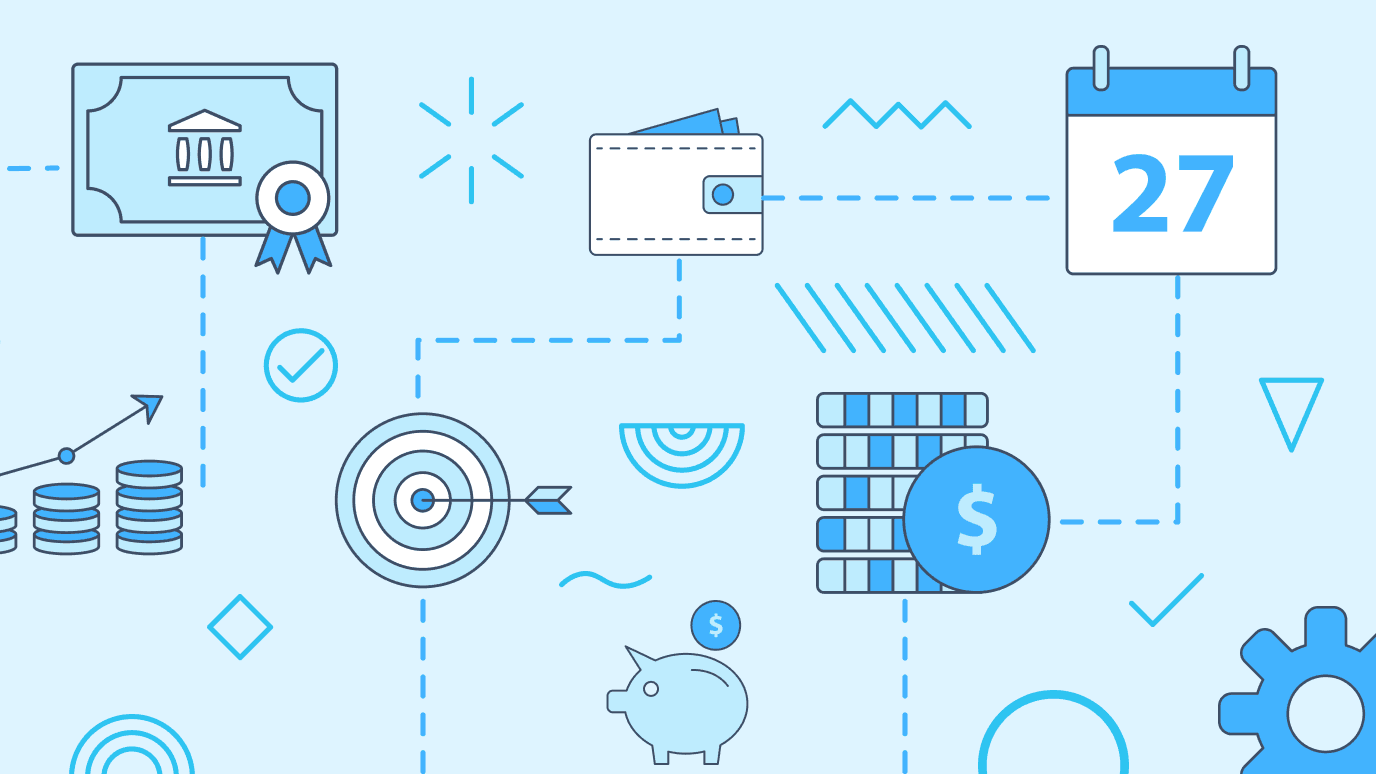May 24, 2023
What Is a Bond?

A bond is essentially an IOU between a borrower (usually a government or a company) and a lender (an investor). When you buy a bond, you’re lending money to the borrower for a set period of time. In return, the borrower promises to pay you back the amount you lent, called the principal, plus interest, which is like a fee for borrowing the money.
Government bonds, municipal bonds, and corporate bonds are issued as a way for those entities to raise funds when they need to finance growth, projects, and operational costs, as well as make payments on previous bonds.
Investing in bonds can offer benefits like steady, fixed income, predictable returns, liquidity, and relatively less risk than stocks. Bonds may also be a useful way to diversify your portfolio.
How do bonds work?
When you buy a bond, you’re giving the issuer a loan. In exchange, the issuer promises to pay you back the principal, aka the amount you loaned, plus interest over a predetermined period of time, known as the bond’s term to maturity. Investors generally receive interest payments twice a year until the bond matures, though interest payment schedules can vary. Upon maturity, the issuer must repay the principal in full. You can think of the lifecycle of a bond as having six key steps:
Issuance: The company, government, or municipality decides they need to borrow money by issuing bonds. At this point, they determine the amount they need to borrow and the terms of the bond, including the interest rate and the maturity date.
Offering: Next, the bond is offered for sale to investors, either through a bond broker or an investment bank. These offerings can be made publicly or privately.
Purchase: Investors can purchase bonds that are up for offer, assuming the role of the lender.
Interest: The issuer pays interest on the bond at a predetermined fixed rate, typically twice a year until the bond matures. Interest rates are based on a combination of factors, including the issuer’s credit rating and the inflation rate.
Maturity: A bond’s maturity date, or the date by which the issuer must repay the principal to the investor, can range from a few months to several decades. The maturity date is determined at the time of issuance.
Redemption: Finally, when the maturity date is reached, the issuer repays the initial loan to the investor.
Bond prices are determined by the interaction of supply and demand in the market. When a bond is first issued, its price is typically set at the face value, which is the amount you will be repaid at maturity. However, after issuance, the bond’s price can fluctuate. One key factor that influences bond prices is changes in interest rates. When interest rates rise, newly issued bonds offer higher yields, making existing bonds with lower yields less attractive. As a result, the prices of existing bonds decrease to align with the new, higher-yielding bonds. Conversely, when interest rates decrease, existing bonds become more appealing, and their prices tend to rise.
Pros and cons of bonds
All types of investments, including bonds, come with potential risks, rewards, pros, and cons. In general, bonds can be less risky than other investments, but there are drawbacks as well.
Pros of investing in bonds
Diversification: Bonds can be an important part of a diversified portfolio, as they may help balance out the volatility of other investments, like stocks.
Risk reduction: Bonds tend to be less risky than investing in stocks, because returns are not tied to fluctuations in a company’s share price, and investors receive their original capital back when the bond matures.
Fixed income: Bond interest payments provide a steady income over time, and because the interest rate is fixed, you’ll know from the start what kind of return to expect on your investment.
Cons of investing in bonds
Lower returns: Bonds have historically produced lower returns than stocks, and the potential for growth is more limited.
Credit risk: Investing in bonds comes with credit risk, which is the risk that a bond issuer may default, failing to make interest payments or even pay back the principal.
Interest rate risk: Changes in interest rates may affect the value of a bond you hold. If interest rates rise above the fixed interest rate locked in when you bought a bond, the bond’s price falls. This risk is known as market risk, and it increases the longer you hold a bond.
It’s important to note that investing in bonds involves trade-offs between risk and return. Bonds offer stability and income but may have lower potential for growth. Evaluating your risk tolerance, investment objectives, and time horizon will help you determine how bonds fit into your overall investment strategy. Understanding the risks associated with bonds, such as credit risk and interest rate risk, allows you to make informed investment decisions.
Types of Bonds
When it comes to purchasing bonds, investors have several options. Types of bonds include:
U.S. government bonds
Corporate bonds
Municipal bonds
U.S. government bonds
These bonds are issued by the U.S. government to support spending like special projects, day-to-day operations, or other financial obligations. Government bonds are considered lower-risk investments because they are backed by the federal government. They tend to pay lower interest rates, but the return is usually steady. Investors can choose from five types of U.S. government bonds.
Treasury Bills (T-Bills): T-bills are short-term investments that reach maturity in one year or less. They’re generally sold in denominations of $1,000, but some may max out at $5 million.
Treasury Notes: These intermediate-term bonds mature in two, three, five, or ten years. They typically have a $1,000 face value, but notes that mature in two or three years generally have a $5,000 face value.
Treasury Bonds: Long-term treasury bonds mature in 10 to 30 years. These bonds help offset shortfalls in the federal budget and regulate the country’s money supply. Treasury bonds have $1,000 face values, and they pay out interest semi-annually.
Treasury Inflation-Protected Securities (TIPS): These securities are indexed to inflation to protect investors from the adverse effects of rising prices. The principal increases with inflation and decreases with deflation.
Floating Rate Notes (FRNs): Issued in electronic form only, FRNs are relatively short-term investments. They mature in two years, pay out interest four times per year, and have an interest rate that may change, or “float,” over time. They’re sold in increments of $100, with a maximum purchase amount of $10 million.
Corporate bonds
Corporate bonds are issued by companies to raise money for ongoing operations, mergers and acquisitions, business expansion, or other financial needs. These bonds generally earn higher yields than their government counterparts, but they are subject to credit and market risks as well. Investors can choose from two different types of corporate bonds.
Investment-grade bonds: These bonds typically have a lower risk of default and receive higher scores from credit rating agencies. Investment-grade bonds tend to be issued at lower yields than other less creditworthy bonds.
Non-investment grade bonds: Also known as a high-yield bond or a junk bond, non-investment grade bonds are deemed more likely to default. Non-investment-grade bonds tend to offer higher yields than investment-grade bonds to compensate for the greater risk.
Municipal bonds
Municipal bonds, “munis” for short, are issued by states, cities, counties, and other governmental entities to fund day-to-day obligations. They’re also used to finance capital projects like building schools, highways, and sewer systems. Generally, these investments are considered low risk; however, municipal bonds are subject to credit, inflation, and interest rate risks just like their corporate and government counterparts. The two most common types of municipal bonds are general obligation bonds and revenue bonds.
General obligation bonds: Issued by states, cities, or counties, general obligation bonds aren’t secured by any assets. Instead, they’re backed by the “full faith and credit” of the issuer, which has the power to tax residents to pay bondholders.
Revenue bonds: Instead of relying on taxes, revenue bonds are backed by revenue from specific municipal sources like lease fees or highway tolls.
Considerations for choosing bonds
When it comes to buying bonds, it’s important to consider a few factors to make informed investment decisions that align with your financial goals and risk tolerance. Here are some key considerations simplified for easy understanding:
Evaluate Your Portfolio and Goals: Before buying bonds, assess your overall investment portfolio and determine how bonds will fit into it. Consider your investment goals, such as income generation or capital preservation. Think about your time horizon, whether you’re investing for the short term or long term, and your risk tolerance, which reflects how comfortable you are with potential fluctuations in your investment’s value.
Research Issuer Credit Ratings: One crucial aspect is the issuer’s financial health. Research the credit ratings assigned to bonds by rating agencies like Standard & Poor’s, Moody’s, or Fitch. These ratings indicate the issuer’s ability to repay its debt obligations. Higher-rated bonds generally have lower default risk but may offer lower yields, while lower-rated bonds may provide higher yields but carry higher credit risk.
Understand Maturity Dates and Coupon Rates: Maturity date refers to the length of time until the bond reaches its full repayment. Consider your investment timeline and when you’ll need access to your funds. Short-term bonds have a maturity of a few months to a few years, while long-term bonds can have maturities of 10, 20, or even 30 years.
Align Investments with Goals, Risk Tolerance, and Time Horizon: It’s essential to align your bond investments with your financial goals, risk tolerance, and time horizon. If you’re seeking stable income and capital preservation, you may opt for high-quality bonds with lower yields but lower risk. If you have a longer time horizon and can tolerate more risk, you might consider higher-yielding bonds, which may have lower credit ratings.
How to buy bonds
Unlike stocks, bonds are not traded on a public exchange. Once you determine the types of bonds you’d like to invest in and the amount you’d like to commit, you can purchase them from a brokerage firm, a bank, directly from the U.S. government, or by investing in an exchange-traded fund (ETF) that holds bonds. Purchasing bonds through ETFs can help further diversify your portfolio and minimize your risks because the fund holds a basket of multiple bonds.
Bonds and your diversified portfolio
Bonds can be a smart addition when diversifying your portfolio with The Stash Way, providing steady fixed income and relatively lower risk than stocks. But they don’t come without risk. As with all investments, do your homework before you dive in.
Whether you’re interested in government, municipal, or corporate bonds, or a combo, Stash can help you find the right balance for your portfolio and work toward your long-term financial goals.

Investing made easy.
Start today with any dollar amount.
Related articles

investing
Dec 11, 2025
How to Invest through the Holidays—Without the Stress

investing
Oct 23, 2025
Why Millions Are Canceling Disney+ and Hulu and What It Means for Investors

investing
Aug 15, 2025
Money Insights

investing
Jul 07, 2025
How to start investing: a guide for beginners

investing
Jun 04, 2025
Growth Stocks to Invest in for 2025

investing
Jun 03, 2025
Sustainable Investing Stocks to go after in 2025
By using this website you agree to our Terms of Use and Privacy Policy. To begin investing on Stash, you must be approved from an account verification perspective and open a brokerage account.
